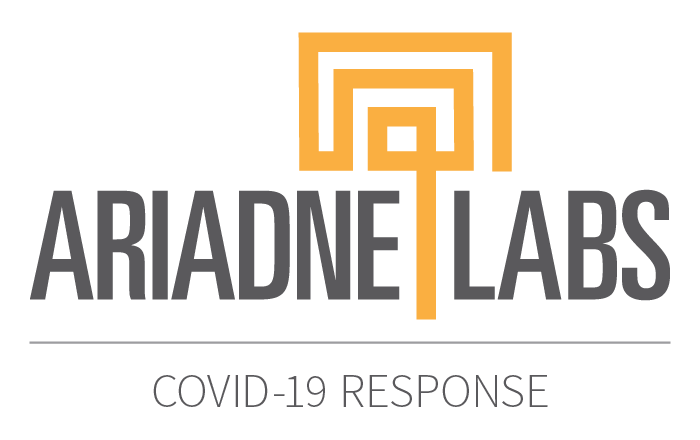We developed the following six innovation categories and standalone, downloadable documentation for how to accelerate the growing momentum for each category, including:
- how the context for each innovation category has changed during the pandemic,
- the ways potential innovations within each category address the three prioritized problem themes of Continuum of Care and Support, Family and Support, and Patient-Provider Relationships, and
- strategies for accelerating momentum for the innovations to leverage the moment for change.
As you read through the categories and examples, we encourage you to think about how they have or could be applied in your organizational context.
We have also included resources to other work happening under each category that we will continue to update. Ariadne Labs and Spring Impact—a non-profit enabling mission-driven organizations and funders to scale social impact—have begun to document some of the innovations surfaced during the Obstetric COVID Innovation Collaborative convenings and to test an emerging framework to generate more practical lessons for health systems leaders and clinicians on the frontlines. The resulting two guides and supporting documentation under “Leverage Virtual Access” and “Adapt Roles and Responsibilities” highlight specific innovations in two key categories.
If you are interested in testing out these guides and providing feedback on how we might improve on these tools, we invite you to collaborate with us.
As you read through the categories and examples, we encourage you to think about how they have or could be applied in your organizational context. Have an example of a promising practice you would like to share? We invite you to collaborate with us.
1. Leverage Virtual Access
Leveraging virtual access includes innovations that provide opportunities to deliver clinical care, education, or support through virtual methods, such as video conferencing, phone calls, or text messages. Our participants reported that there was already great perceived need for virtual access (e.g. increasing access for people who are primary caregivers and face conflicts between their own caregiving responsibilities and their ability to access care for themselves), but social distancing during the COVID-19 pandemic made this need acute.
Innovation Implementation Guidance: Virtual support groups for new parents
This guide documents some of the common elements from three virtual support groups for new parents, and draws out the lessons for other health system leaders who may want to adopt similar innovations. We have documented the core components of the three innovations we researched so that you can identify the specific elements that might need to be set up if you want to introduce this into your setting. We have also described how you might adapt or flex elements of the model into your context, where there are important contextual differences.
2. Build Trust & Enhance Communication
Building trust and enhancing communication includes innovations that provide opportunities to address the longstanding breach of trust between health systems and communities, especially for those who have been historically oppressed, marginalized, and underserved by health systems. This breach has been exacerbated by the disproportionate impact of the pandemic on communities of color, as well as many of the necessary policies put in place, including new spatial protections, PPE, and limitations on hospital visitation.
3. Customize Care Planning & Support
Customizing care planning and support includes innovations that adapt existing care approaches for routine prenatal and postpartum care to better meet birthing peoples’ unique needs. Professional societies have recently highlighted that current practices and visit schedules are not based on strong evidence for what produces the best experiences and outcomes for birthing people. There is and has been demand for this change, and disruptions to routine modes of care during COVID-19 has created an opportunity among some systems to take new approaches, including revisiting the frequency, duration, interval, format, and location of appointments.
Aspire COVID-19
The ASPIRE project will find out what has worked best in the UK and in the Netherlands to ensure safe and personalized care for mothers, babies, and partners during and after a pandemic, so that, in the future, mothers and babies don’t miss out on good quality maternity care.
4. Coordinate Existing Services & Needs
Coordinating existing services and needs includes innovations that integrate clinical and social services to help avoid disjointed care for the birthing person. Demand for this coordination existed prior to the pandemic, and this need has been exacerbated by confusion and abrupt changes to hospital policies during COVID-19, increasing isolation, fewer touch-points for screenings for social services, and worsening disparities in low-income communities and communities of color.
5. Adapt Roles & Responsibilities
Adapting roles and responsibilities includes innovations that promote non-clinical and clinical capacity for providing emotional, informational, and physical support for birthing people throughout their pregnancy, childbirth, and postpartum. During the first wave of COVID-19, many clinicians were redeployed to new services, and staffing models were adapted to both meet capacity and limit staff exposure. These changes required flexibility in roles and responsibilities and also revealed potential to adapt going forward.
Innovation Implementation Guidance: Emory Decatur Labor Support Volunteers (EDLSV)
This innovation fits in the category of Adapting Roles & Responsibilities by expanding support capacity, such as training and employing more doulas and developing new advocate and navigation roles. We have documented the innovation developed by Emory so that you can identify the specific core components that might need to be set up if you want to introduce this into your setting. We have also described how you might adapt or flex elements of the model into your context, where there are important contextual differences.
6. Utilize Alternate Care Settings
Utilizing alternate care settings includes innovations that repurpose, convert, or construct new space to deliver care. During the pandemic, particularly during surges in cases, health systems have needed to identify additional spaces for patient care to accommodate increased volume and lengths of stay, while also reducing the density of people within existing spaces.
Partner Organization Resources:
- PRIORITY: Pregnancy Coronavirus Outcomes Registry (UCSF)
- Global Perinatal Task Force on Quality Perinatal Care during COVID-19 (Birth Place Lab)
- The impact of COVID-19 on service provision and maternal and neonatal outcomes, through the lens of inequalities (The Health Foundation)
- Maternity Care Innovations During COVID-19: Short-Term Solutions, Long-Term Potential (The Commonwealth Fund)
If you are interested in getting involved in this work or want to learn more, we invite you to collaborate with us.


